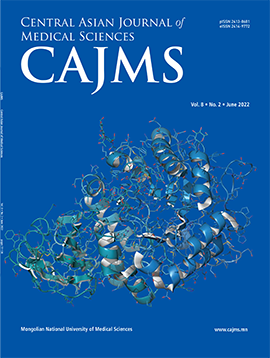Risk Factors and Clinical Characteristics of Congenital Primary Hypothyroidism: A Case-control Study in Ulaanbaatar, Mongolia
DOI:
https://doi.org/10.24079/cajms.2021.06.004Keywords:
Congenital Primary Hypothyroidism, Risk Factors, Clinical Signs, Thyroid DiseaseAbstract
Objective: The study aimed to identify the risk factors and clinical features of congenital primary hypothyroidism (CPH). Methods: A matched case-control study recruited all children diagnosed with congenital primary hypothyroidism and children without disease as a control between 2012 and 2020. Controls were matched on their gender and age. We collected information on demographic, clinical, and laboratory characteristics from patient’s medical records. Results: The birth weight (OR = 1.1; p = 0.001), gestational age (OR = 2.24; p < 0.001), maternal age (OR = 1.21; p < 0.001), additional congenital disabilities (OR = 1.1; p = 0.015) and maternal hyperthyroidism (OR = 1.21; p < 0.011) were significant factors for CPH. The baby’s height (OR = 0.2; p = 0.012), maternal gestational diabetes (OR = 0.2; p = 0.002) and being a twin (OR = 0.91; p = 0.010) were significant protective factors for CPH. In terms of clinical symptoms of CPH, 70.2% had shown no clinical signs at births in our study. The most commonly identified clinical signs were: umbilical hernia, open posterior fontanel, feeding difficulty, hypothermia, abdominal stiffness, cold or mottled skin, prolonged jaundice, and low muscle tone. Conclusion: Children with CPH are often symptom-free at birth, and several risk factors contribute to CPH.
Downloads
253
Downloads
Published
How to Cite
Issue
Section
License
Copyright (c) 2021 Mongolian National University of Medical Sciences

This work is licensed under a Creative Commons Attribution-NonCommercial 4.0 International License.




